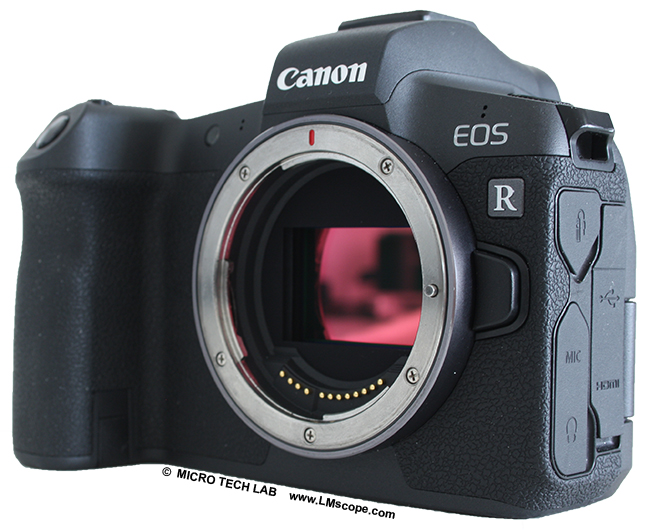

Using affordable, high-resolution digital cameras on “M” series Leica stereomicroscopes? No problem with our LM digital adapters!
Leica’s “M” series microscopes offer a selection of different tube options, which means that there are also several connection options for cameras and other devices. The modular design and the high optical quality of our LM adapter solutions make it easy to achieve top-notch image quality.
If you’re looking to buy a new camera, we recommend either a DSLR (digital single lens reflex) or DSLM (digital single lens mirrorless) camera. Both feature powerful, high-quality image sensors that produce amazing images. Especially when used on stereomicroscopes, where subjects are typically viewed at low magnifications, large sensors deliver a much better image quality than normal C-mount cameras with very small sensor formats. For truly superb image quality, we recommend the latest full-frame cameras, although more affordable entry-level cameras with slightly smaller APS-C sensors also produce great results. For more information on making a camera selection, please visit our two info pages: camera recommendations and camera ranking

For photography applications, Leica’s “M” series offers several possibilities for connecting a camera to the microscope. We carry an adapter solution for each of these possibilities:
Option A
The easiest and most budget-friendly way to attach a camera to a microscope is to connect it to the eyepiece tube. One of the microscope’s eyepieces is removed and the camera-adapter combination is put in its place. This adapter solution is very flexible, because it can also be used on other microscopes with standard-sized eyepiece tubes (23.2 mm and 30 mm). The optical quality is very good and matches the price level of a phototube adapter solution. However, this option is somewhat inconvenient for routine microscope work, because it requires giving up one eyepiece.

Option B
Leica offers two types of beam splitters (HF F10 446 308 or HF V10 446 309), which split the light path to allow a camera to be attached to the microscope. Our LM microscope adapters make it possible to use a variety of different digital cameras – DSLRs, DSLMs, compact cameras, camcorders or C-mount cameras – with the Leica “M” series microscopes.

Option C
Leica also offers a trinocular head with camera port (37 mm) for the “M” series microscopes, to which the camera-adapter combination is attached.
Trinocular head Leica 10 445 924 50%
Trinocular head Leica 10 446 229 100%

As can be seen in the image above, the adapter solution is the same as in option B. However, this option with Leica’s trinocular head 10 445 229 (100%) delivers a better image quality than the beam splitter option, because the setup is simpler (fewer optical elements are in the beam path). If you’re considering the purchase of a new camera, we recommend this option.
Modern Leica stereomicroscopes usually have a phototube with the required dimensions.

Photography:
Fitting the microscope to digital single-lens reflex (DSLR), mirrorless interchangeable-lens cameras (MILC ), digital single-lens mirrorless (DSLM) or C-mount cameras is easy with our LM digital SLR adapters, which feature a plan achromatic optical system. Our products make it possible to capture top-quality microscope images. To help you select the adapter that is right for your camera, we have set up an online configurator on our website. You can also email us – ideally with attached photographs of your microscope.
Modern DSLR and single-lens mirrorless (DSLM) offer the latest technology and are generally very well suited for microscopy applications. Most of them can be controlled remotely via PC/Mac. Because of their high sales volumes, they offer an excellent price/performance ratio compared to special-purpose microscope cameras.
Features of top DSLR and single-lens mirrorless cameras (DSLM):
- Large, powerful full-frame sensors (36 x 24 mm)
- Sensor resolution of 61 megapixels or 240 megapixels with Pixel Shift technology
- High light sensitivity (ISO 400,000+)
- Extensive dynamic range (up to 15 aperture stops/f-stops)
- Short exposure times (1/8000 second) up to 1/32,000 seconds using the digital shutter
- 4K Ultra HD or 8K Ultra HD video function
- Live video capture on external monitors in ultra HD quality
In most cases, these cameras are significantly more powerful than microscope cameras with smaller sensors (1/2" or 2/3"). On our website you will find our current camera recommendations and a camera ranking which is specifically tailored to microscopy applications.
New LM Digital Adapter for: Sony Alpha 9 III / Nikon Z9 / Nikon Z8 / Sony Alpha 7R V / Sony Alpha 1 II / Sony Alpha 1 / Sony Alpha 9 II (ILCE-9M2) / Sony FX3 Cinema Line / Sony Alpha 9 / Nikon D6 / Canon EOS R3 / Canon EOS R6 Mark II / Canon EOS R8 / Sony Alpha 7R IV / Canon EOS R5 II / Nikon Z6III / Canon EOS R5 / Sony Alpha 7S II / Sony Alpha 7S III / Sony Alpha 7R III / Canon EOS R6 / Nikon Z6 / Nikon Z6II / Sony Alpha 7R II / Nikon Z7 / Nikon Z7II / Canon EOS R / Canon EOS Ra (Astro) / Nikon Z5 / Sony Alpha 7C / Canon EOS RP /